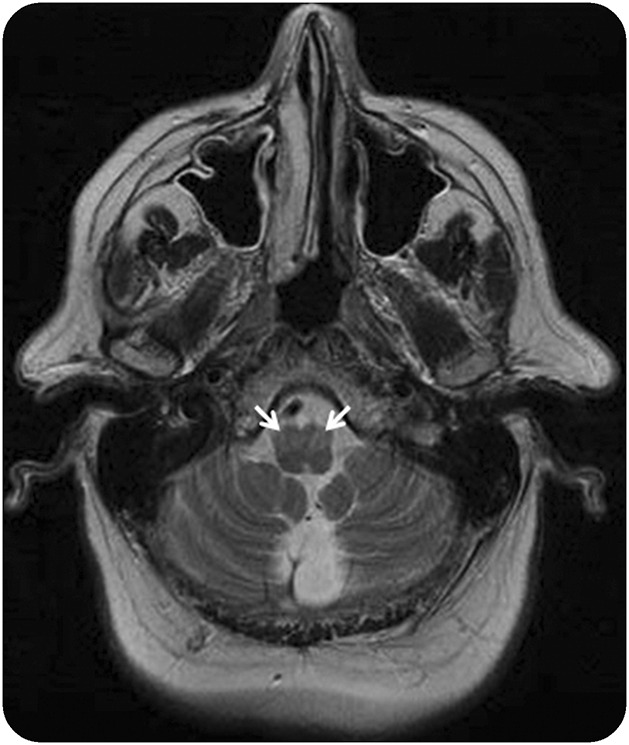A 67-year-old man presented with a several-year history of progressive gait ataxia, dysarthria, and a 2-Hz palatal tremor (video on the Neurology® Web site at Neurology.org). He did not have corticospinal tract signs. Cranial MRI revealed hypertrophic olivary degeneration on T2-weighted images (figure). Genetic testing revealed a transition C > T, nucleotide position 235, codon 79, resulting in an arginine > cysteine change, which is a known pathogenic DNA sequence variant within the glial fibrillary acidic protein gene, confirming adult-onset Alexander disease. Symptomatic palatal tremor (SPT) results from a lesion within the dentato-rubral-olivary tracts. SPT is produced by contraction of the levator veli palatini and is usually accompanied by other neurologic signs. Essential palatal tremor, an idiopathic tremor of the tensor veli palatini, has a similar appearance to SPT, but is accompanied by a clicking sound within the ear and without additional neurologic deficits.
Figure. MRI reveals hypertrophic olivary degeneration.

Cranial MRI reveals hypertrophic olivary degeneration on T2-weighted images.
Supplementary Material
Footnotes
Supplemental data at Neurology.org
Download teaching slides: Neurology.org
AUTHOR CONTRIBUTIONS
Dr. Sebesto was responsible for analysis and interpretation of data, drafting/revising the manuscript for content, study concept/design, and final approval of the manuscript. Dr. van Gerpen was responsible for analysis and interpretation of data, drafting/revising the manuscript for content, study concept/design, and final approval of the manuscript.
STUDY FUNDING
No targeted funding reported.
DISCLOSURE
J. Sebesto reports no disclosures relevant to the manuscript. J. van Gerpen receives funding from NIH P50NS072187, but this funding is not relevant to this manuscript. Go to Neurology.org for full disclosures.
Associated Data
This section collects any data citations, data availability statements, or supplementary materials included in this article.


